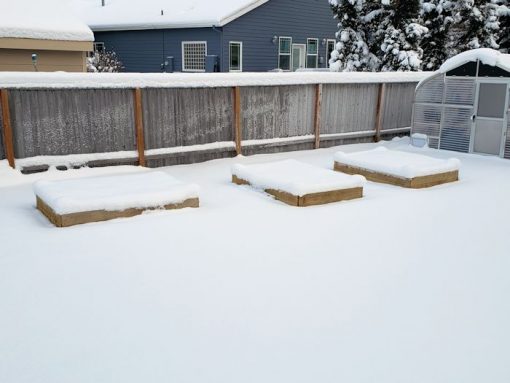One of the fallouts from the Alaska Master Gardener Online course has been an appreciation of crop rotation, yet another thing I haven’t been doing. This is a bit of a planning / thought piece on how to set up a workable system. What better time to do this than in the dead of winter?
Raised Beds
Many years ago, I constructed three raised beds in the lowest, wettest part of the yard, affectionately referred to as ‘the swamp’. The goal was to productively use this part of the yard and keep foot traffic on the grass to a minimum. Over the years, at least that part of the plan has been successful.
But when you build raised beds, you want to use the darned things. Over the years, we have planted various vegetables and conducted a rudimentary crop rotation scheme. It is this scheme that I need to improve.
We have three raised beds constructed out of cedar fence planks attached to a 4 x 4 post in the corners. They measure 4’ x 6’ and are 18′ deep. They are filled with good soil and I mulch them every fall a few inches deep with grass, vegetable debris that return nutrients to the soil over the course of the winter. I do not fertilize, though the beds do get a good dose of compost tea in late May. The worst weeds are grass growing mainly along the sides. Chickweed loves the raised beds and pulling it is a regular part of our summer.
We have 72 square feet (ft2) available for planting in three 24 ft2 chunks.
Plants
Over the years, we have ended up with the following regular crops:
- Yacon — Sunflower family (Asteraceae)
- Carrots — Carrot family (Apiaceae)
- Zucchini — Gourd family (Cucuritaceae)
- Summer squash – Gourd family (Cucuritaceae)
- Bok choy – Mustard family (Brassicaceae)
- Broccoli — Mustard family (Brassicaceae)
- Cauliflower – Mustard family (Brassicaceae)
- Kohlrabi – Mustard family (Brassicaceae)
- Swiss chard — Goosefoot family (Chenopodiaceae)
- Beans — Pea family (Fabaceae)
Crop rotation is generally based on rotating families, with the same family in the same patch of ground one growing season out of every 3 – 4 years. This information comes from Wisconsin Horticulture, Division of Extension.
Families
The various families are generally grouped into 4 buckets for purposes of rotation. Here is a breakdown of those families in a suggested order of rotation:
- Leaf — broccoli, cauliflower, kohlrabi, yacon
- Fruit – zucchini, squash
- Root — carrots, swiss chard
- Legume — beans
Clearly, we plant a lot of leaf veggies and not all that much of everything else. Things get more interesting when you take a look at our actual yearly coverage for each plant type.
- Leaf — broccoli, cauliflower, kohlrabi, bok choy (24 ft2), yacon (12 ft2)
- Fruit — zucchini, squash (12 ft2)
- Root — carrots (6 ft2), swiss chard (8 ft2)
- Legume — beans (4 ft2)
This leaves a quarter of a bed (6 ft2) without anything planted in it. If I were to expand any coverage, it should be beans or carrots (or something else in those groups).
Clearly, I am not planting enough beans to revitalize the soil with nitrogen, though I do fill that need at least on the surface by burying the raised beds with at least half a foot of grass clippings after harvest in August.
Rotation
A very simple rotation would be the following matrix:
| Year 1 | Year 2 | Year 3 | |
| Bed 1 | Leaf | Fruit / yacon | Root / legume |
| Bed 2 | Root / legume | Leaf | Fruit / yacon |
| Bed 3 | Fruit / yacon | Root / legume | leaf |
Analysis
Over the years, we have heavily planted broccoli and kohlrabi, perhaps 1 ½ bed’s worth. The last couple years, this has decreased as our eating habits changed. While we always like zucchini and squash, our plants were not been very productive. Last summer was glorious, likely due to the nice, warm summer, though our selected Anton variety may have helped a bit. We would like to do this again this summer. Will see if the weather cooperates.
The other thing to consider would be construction of a fourth raised bed for proper crop rotation.
I have been keeping a record of what we plant and how it does for the last 4 years. Adding a page recording crop rotation is a relatively easy way to keep track, and most importantly plan on what we need to do this summer.
Final thoughts
Although no plan survives first contact with reality intact, setting up at least a thumbnail plan for crop rotation in a group of raised beds is a useful exercise to revitalize the soil in those raised beds. Done right, it might even help improve our production. What a concept!
Additional information
Vegetable Garden: Crop Rotation Made Easy
Crop Rotation for Growing Vegetables
Crop Rotation Made Easy
Maintain Healthy Soil with Crop Rotation
About Alex Gimarc
Twitter •

A super informative article with tons of tips. Thanks!!!